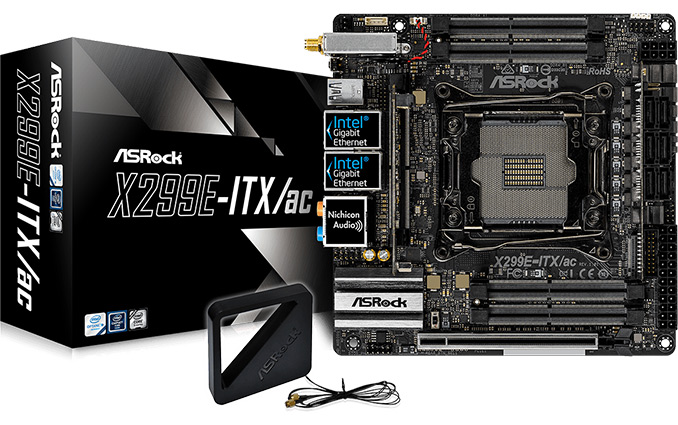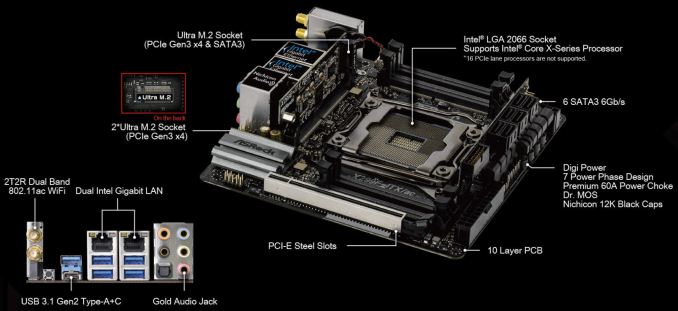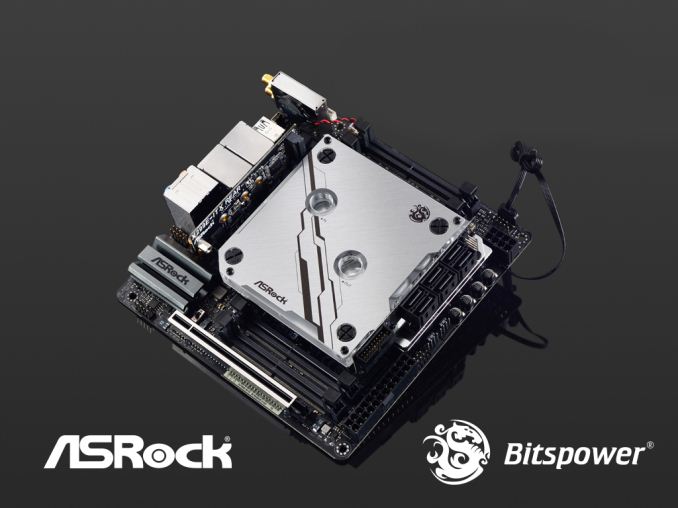ASRock’s X299E-ITX/ac Motherboard Now Available: Up to 18 Cores in Mini-ITX
by Anton Shilov on October 19, 2017 2:00 PM EST
ASRock formally introduced its X299E-ITX/ac motherboard at Computex earlier this year and attracted a lot of attention to the product that was (and still is) the only Mini-ITX mainboard for Intel’s Core i7 and Core i9 processors in LGA2066 packaging. ASRock had said that this week it has started shipments of the motherboard and it is now available from multiple retailers.
It is noteworthy that since Computex, ASRock has removed the support for the Kaby Lake-X CPUs and therefore the chips will not work on this motherboard. It is compatible only with Skylake-X processors, and enables a user to build a Mini-ITX PC with a CPU featuring up to 18 cores. Since such CPUs have a TDP of 165 W (often drawing more than this at load), and as it can be difficult to find a small cooler for such power, ASRock has worked with Bitspower to develop a custom water monoblock specifically for the X299E-ITX/ac. This monoblock is also being made available.
Despite its small size, the ASRock X299E-ITX/ac supports most of the benefits that Intel’s X299 platform has to offer: it has an advanced VRM with seven phases, 60 A inductors and 12K solid-state capacitors enabling CPU overclocking, it has four SO-DIMM DDR4 memory slots for full memory bandwidth support, one PCIe 3.0 x16 slot for graphics cards, and three M.2 slots for SSDs (PCIe 3.0 x4 or SATA).
Expandability does not end there - the X299E-ITX/ac carries six SATA 6 Gbps ports, a 2x2 802.11ac Wi-Fi + Bluetooth 4.2 module (based on an Intel controller), two GbE ports from Intel controllers, two USB 3.1 10 Gbps headers (a Type-A and a Type-C), six USB 3.0 connectors, a 7.1-channel audio sub-system enabled by the Realtek ALC1220 controller and so on.
| ASRock's Mini-ITX Motherboard for Intel Core X-Series | ||
| X299E-ITX/ac | ||
| CPU Support | Intel Core i9 Intel Core i7 Skylake-X CPUs in LGA2066 form-factor |
|
| Graphics | PCIe 3.0 x16 | |
| Chipset | Intel X299 | |
| Memory | Four DDR4 SO-DIMM slots | |
| Ethernet | 2 × Intel GbE controllers | |
| Storage | 6 × SATA 6 Gbps 3 × M.2 (PCIe 3.0 x4 or SATA) |
|
| Audio | Realtek ALC1220 7.1 channel audio |
|
| USB | 6 × USB 3.0 Type-A 1 × USB 3.1 Type-A 1 × USB 3.1 Type-C |
|
| Other I/O | Dual-band 802.11ac Wi-Fi + Bluetooth 4.2 | |
| Form-Factor | Mini-ITX | |
| Price at Launch | $400 at Newegg $400 ~ $500, depending on the region |
|
In order to fit everything it wanted onto a Mini-ITX PCB, ASRock had to place the USB 3.1 controller, SATA ports and one M.2 slot on custom daughter-board modules - essentially going vertical when they ran out of horizontal space. Such modules add certain dimension-related limitations to the size of CPU coolers (it remains to be seen how higher-end M.2 SSDs perform when located near a CPU cooler) and that is a problem because all of the Core i7 or i9 processors supported by this motherboard have TDP of 140-165 W, and it is not easy to cool such chips down. In fact, when it comes to the X299E-ITX/ac, a custom liquid cooled setup could be the most optimal choice from performance and dimensions point of view (again, assuming that an appropriate chassis is used for the build).
Bitpower has developed a custom waterblock/monoblock specifically for the X299E-ITX/ac, with a product ID of BP-WBMASRX299EI. This monoblock features a copper base with a nickel finish with two G1/4" fittings and even RGB lighting. The waterblock is available directly from the manufacturer and it is compatible with standard pumps and tubings.
Speaking of availability, the ASRock X299E-ITX/ac is now available from Newegg for $400 (although it already looks to be sold out as we wrote this piece). In Europe, three stores are taking pre-orders and are charging from €424 to €461 ($502 to $546) per unit, so the motherboard is quite expensive, possibly because it is unique.
Related Reading
Source: ASRock


















27 Comments
View All Comments
shabby - Thursday, October 19, 2017 - link
This board makes zero sense, can someone point out some actual use cases where it does seeing the monstrous coming solution it needs?Vatharian - Thursday, October 19, 2017 - link
Here you go. Possible use cases: a) customers who want to show off, and build smallest and yet the most powerful machine available, b) workstation build with extremely small footprint, enough to put it beside monitor, not under the desk, c) as second motherboard in dual-system build, for handling storage and other background tasks (stream capture? And I'm not talking about video only), d) high density computing, without going full-server grade, e) backup system for a full-fledged workstation, with offline computing/rendering capability (main system offline, I mean).I'd love to see this board with single 10G controller!
sharath.naik - Thursday, October 19, 2017 - link
Best case.. this is perfect for those who want a portable gaming desktop. but do not want to build a separate system for high core count computing. For example you can put this into a Dan's A4-SFX case (7 liters), have 64 GB Ram, 18 core, all the storage you need and still have a full 1080ti or above in it. Again all in a 7 liter case. Until now this form factor always had to deal with storage or ram or port compromises, with this no more.shabby - Thursday, October 19, 2017 - link
And which cooler will fit in that case to cool down that 200 watt cpu?sharath.naik - Friday, October 20, 2017 - link
I have a dynatron r30 low profile cooler on a 160watt xeon 2696 v4 cpu. It works well. There are a few options. Also you can go with aio which the case allows.Though i wished someone released a quad memory slot motherboard in a micro atx form factor, which you still donot get.
lmcd - Friday, October 20, 2017 - link
One thing that's always confused me -- M.2 and, before that, SATA SSDs regularly go on the back of the mobo for ITX (and sometimes mATX and ATX as well). Why couldn't laptop RAM go back there? You could put 2 back there and 2 on the front, among other arrangements.edzieba - Sunday, October 22, 2017 - link
"Why couldn't laptop RAM go back there? "A single-sided m.2 drive and its mounting hardware fit within the existing standoff clearance specifications. A SODIMM slot (even a 'low profile' one) does not. This means that by placing the SODIMM slots on the rear, your motherboard is now incompatible with existing cases and neds a custom case. And at that point, you may as well go Full Custom anyway (e.g. ASRock's Mini-STX boards).
WithoutWeakness - Thursday, October 19, 2017 - link
I have the previous X99 model of this board. It is the perfect board for my media server needs. I have an M.2 NVME SSD as the boot drive and 3 pairs of hard drives in RAID-1 for data storage. I'm currently running a 6-core i7 and have the option to upgrade to a much higher core count Xeon if I need more processing power down the line. This one system runs both my NAS and Plex server in a Fractal Node 304 which is basically the size of a shoe box. It's impressively dense given the amount of storage and compute power I have in that one small case.quorm - Friday, October 20, 2017 - link
Couldn't you easily run a nas and Plex on an i3 or lower?lmcd - Friday, October 20, 2017 - link
Real-time encoding needs vary per client devices. Sometimes the source might be taxing as well.